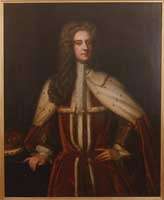Thomas Browne, 4th Viscount Kenmare

Thomas Browne, 6th Baronet & 4th Viscount Kenmare (April 1726 – 11 September 1795) was an Irish landowner and politician. He was probably born at Killarney, County Kerry, the second of four children of Valentine Browne, fifth Baronet, third Viscount Kenmare (1695–1736), one of the few remaining great Roman Catholic landowners in Ireland, and his first wife, Honoria Butler (?-1730). Thomas Browne's great-grandfather, Sir Valentine Browne, third Baronet, had been created first Viscount Kenmare by James II in March 1689. This was an Irish peerage created after the removal of James II from the English throne, but during the period when James was de facto king of Ireland, before the conquest of Ireland by William III. The first and second viscounts had fought for James II but seem never to have been formally attainted under William. Consequently, the peerage remained on the Irish patent roll in a constitutionally ambiguous position, but was not formally recognised by the Protestant political establishment.
Thomas Browne was reportedly educated at Westminster School until the death of his father in 1736. Browne's older brother, Valentine, had died in 1728, so Thomas inherited the peerage and the estate (of more than 120,000 acres) intact. Repeated attempts to persuade him to convert to the English established church came to nothing, even though his refusal cost him a university matriculation at Oxford and a place in the English House of Commons. In 1750, he married Anne Cooke, daughter of Thomas Cooke of Painstown, County Carlow, with whom he had two children.
Kenmare's aristocratic status and landownership naturally led him to play a prominent role in Catholic politics during the later eighteenth century. Kenmare sought to show that Roman Catholics could be incorporated in the Protestant settlement of eighteenth-century Ireland. In the early 1760s, he proposed unsuccessfully the establishment of an Irish regiment, with Catholic officers as well as other ranks, formally in Portuguese service but in practice supporting Britain's effort during the Seven Years' War. At the same time, Kenmare, and other heads of Catholic families, were suspected by some Protestants of organising the Whiteboy agrarian riots in Munster as part of a conspiracy to gain power in Ireland with French assistance. The desire of prominent Catholics to show that they did not wish forcibly to overthrow the constitutional settlement contributed to the development of the Catholic Committee, formed to argue for Catholic relief in Ireland. During the 1770s, with Arthur James Plunkett, seventh earl of Fingall, and Anthony Preston, eleventh Viscount Gormanston, as well as a number of senior bishops, Kenmare formed a conservative party on the committee, arguing that Catholic relief was best obtained by producing declarations of loyalty and maintaining good relations with the Dublin and London administrations. This group became the dominant force on the committee.
Kenmare's correspondence with Edmund Burke shows that he maintained communication with the British parliamentary opposition, but he principally regarded the economic and constitutional reform championed by the Rockingham whigs and their Irish allies as a distraction that conflicted with his wish to maintain close ties with the government. To this end, he supported the recruitment of soldiers in Ireland to fight for Britain in the American War of Independence during the 1770s. His pro-government policy began to pay dividends when the first important Relief Acts were passed in 1778 and 1782, though other factors, including the development of Irish patriotism, the decline of Jacobitism, and the changing imperial context, were undoubtedly important as well.
The political ferment in Ireland following the recognition of legislative independence in 1782 threatened Kenmare's strategy. Demands for the widening of the parliamentary franchise among the volunteer and patriot movements raised the question of whether Catholics should be included in any measure of reform, but involvement in the campaign was opposed by Kenmare and the conservatives on the committee, which never actually discussed the issue. On 11 November 1783, at the start of a discussion on Catholic relief at the national convention of volunteers in Dublin, George Ogle, a Wexford MP, announced that he had received "a letter from a Roman Catholic peer expressive of the sentiments of the Catholics in general … that they had relinquished the idea of making any claims further than the religious liberties they enjoyed." Ogle's intervention stopped debate on Catholic claims. Though purportedly written by Kenmare, the letter was actually composed by his cousin, Sir Boyle Roche, who, as a Protestant, had represented Kenmare's views in the Commons. Kenmare could therefore deny authorship, ensuring that no break with the administration occurred, and that division in the committee was avoided.
Lord Kenmare died at Killarney on 11 September 1795, and was succeeded by his son Valentine Browne (1754–1812), who maintained his father's political stance, and was created earl of Kenmare in 1801.
References
- H. C. G. Matthew and Brian Harrison, ed. (2004). ""Browne, Thomas, fourth Viscount Kenmare"". The Dictionary of National Biography. Oxford: Oxford University Press. ISBN 0-19-861411-X.